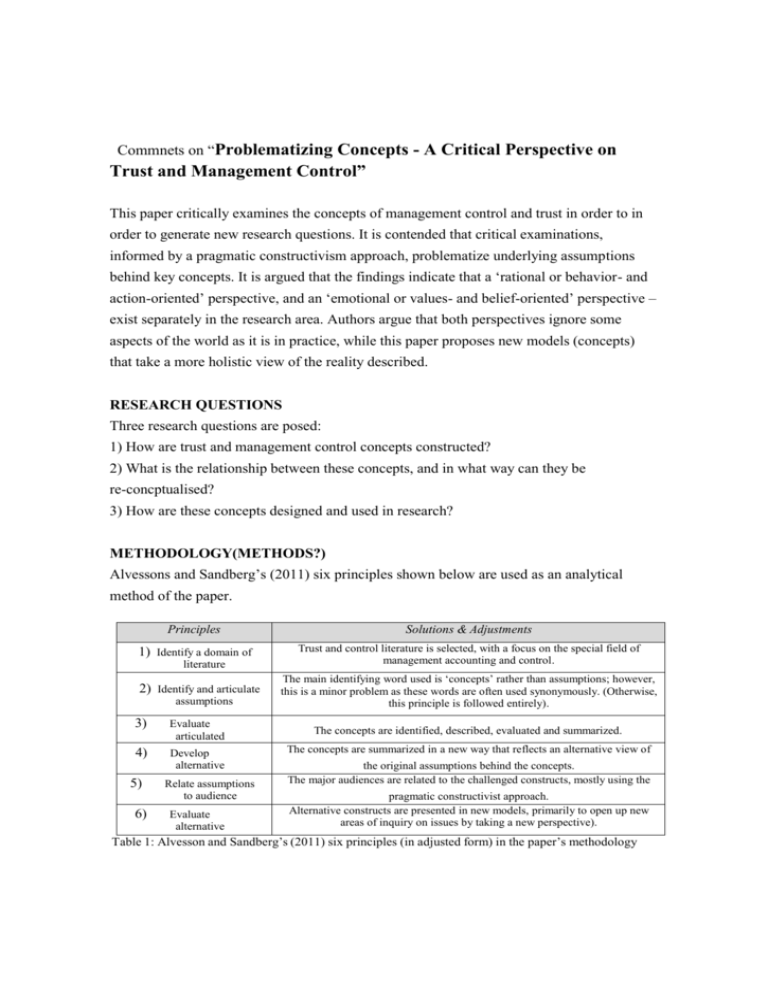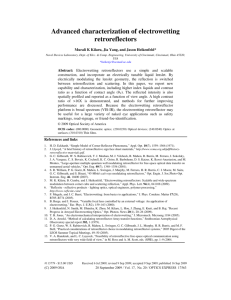view comments
advertisement

Commnets on “Problematizing Concepts - A Critical Perspective on Trust and Management Control” This paper critically examines the concepts of management control and trust in order to in order to generate new research questions. It is contended that critical examinations, informed by a pragmatic constructivism approach, problematize underlying assumptions behind key concepts. It is argued that the findings indicate that a ‘rational or behavior- and action-oriented’ perspective, and an ‘emotional or values- and belief-oriented’ perspective – exist separately in the research area. Authors argue that both perspectives ignore some aspects of the world as it is in practice, while this paper proposes new models (concepts) that take a more holistic view of the reality described. RESEARCH QUESTIONS Three research questions are posed: 1) How are trust and management control concepts constructed? 2) What is the relationship between these concepts, and in what way can they be re-concptualised? 3) How are these concepts designed and used in research? METHODOLOGY(METHODS?) Alvessons and Sandberg’s (2011) six principles shown below are used as an analytical method of the paper. Principles Solutions & Adjustments 1) Identify a domain of Trust and control literature is selected, with a focus on the special field of management accounting and control. literature 2) Identify and articulate assumptions 3) 4) 5) 6) Evaluate articulated assumptions Develop alternative assumptions Relate assumptions to audience The main identifying word used is ‘concepts’ rather than assumptions; however, this is a minor problem as these words are often used synonymously. (Otherwise, this principle is followed entirely). The concepts are identified, described, evaluated and summarized. The concepts are summarized in a new way that reflects an alternative view of the original assumptions behind the concepts. The major audiences are related to the challenged constructs, mostly using the pragmatic constructivist approach. Alternative constructs are presented in new models, primarily to open up new areas of inquiry on issues by taking a new perspective). Evaluate alternative assumptions Table 1: Alvesson and Sandberg’s (2011) six principles (in adjusted form) in the paper’s methodology Pragmatic constructivism (Norreklit et al., 2006) is used to re-conceptualise and create new models by integrating four aspects of reality: facts, logic, values and communication. COMMENTS This paper discusses number of academically important topics for critical accounting researchers in an interesting and innovative manner. This paper covers vast range of literature with varying methodological, theoretical approaches. It seems that theories, concepts, and to a lesser extent models, are treated as empirical objects and analysed in inductive manner using above mentioned methods. Unfortunately, it seems that three research questions are not systematically answered in the paper and the arguments developed is not easy to follow. This is partly because of the lack of detailed knowledge of the reader/writer of this comments. The following are some of the reasons why it is found to be difficult to follow. 1) Dichotomy between older management control types (Bureaucracy) and newer management control types (Post-bureaucracy) does not fit well with current development in the literature. For instance, enabling bureaucracy (Adler and Borys1996) and enabling control (Ahrens & Chapman 2004) explicitly argue that two types are intertwined. In management science, literature on organizational ambidexterity (Tushman & O’Reilly 1996) argues that any sustaibale competitiveness should rest upon the combination of two types. Older management control types (Bureaucracy) Newer management control types (Post-bureaucracy) Rational control System Normative control Meritocratic control rationalizations Organizational culture Texts, scripts, protocols Cultural control Identification & subjectification Socio-ideological control = Attempts to control employees’ Beliefs Depending on images = Symbolic register Predictable & determined practices = Imaginary register Ad hoc solutions require creativity control to directly TechnocraticFormulized control = Attempts control employees’ behavior Table 2: Control concepts characteristic of the ‘Bureaucracy’ and the ‘Post-bureaucracy’ 2) A proposed typology of management control summarized in Fig 3 seems very simplistic if not misleading. For example, diagnostic control (Simons 1995) is said to focus on entire control period while result control (Merchant & Van der Stede 2003) focus solely on end of control period. Result control, if understood in combination with delegation of power and responsibility and management by exception, has similar systematic structure and functionality with diagnostic control to me. 3) Critical analysis of concepts of trust is based on the idea that there are two schools of thought/discipline; behavioral school and psychological school. Please explain the reasons why authors have chosen these two schools in expense of other schools and how authors identified varying concepts with each school. 4) A proposed typology of trust summarized in Fig. 5 is confusing in various ways. Firstly, Fig 5 has two different set of two axes, system-people trust axis (horizontal) and emotional-rational trust axis (vertical). One set of axes is used to located different concepts of trust in behavioral school, while the other set is used to locate same concepts in psychological school. It implies that same label is used in two schools systematically differently. Please elaborate how you developed those two sets of axes. Secondly, the coordinate in Fig. 5 means that the distance from the origin matters. For example, “calculus trust” and “deterrence trust” are in the same corner but calculus being more on the rational trust side and less on the system trust side, whereas deterrence is on the less rational trust side and more system trust side without no overlaps. It is not easy to understand how authors located concepts in this way. Thirdly, with the exception of overlaps between characteristic and knowledge trust, each trust concepts are separately located in the Fig. 5. As far as definitions go, it is more likely that concepts are overlapping or in inclusion relations. Fourthly, it is argued that interrogation mark “?” in Fig. 5 tells us that “no school seems to include this dimension of trust” (p.18). For example, on the right bottom corner has two interrogation marks, one on people trust side and the other on rational trust side. Various types of agency theoretic studies as well as behavioral economics based research seems examine issues in this corner in recent years. 5) The arguments represented in Fig. 8 is understandable that time matters. However, combined with the topology represented in Fig . 5, it is confusing. Identification-based trust in the Fig. 5 is located on the upper right corner (emotional-people trust), while the left box of Fig. 8 shows that identification-based trust moves from emotional trust to rational trust, which in turn implies that the identification-based trust in Fig. 5 should be relocated to the bottom right corner (rational-people trust corner). 6) As many, if not most, of conceptual analysis and synthesis is difficult to follow, the final analysis and synthesis of trust and control represented in Fig. 9 and 10 are not very convincing, unfortunately. Adding to the above mentioned confusions, new confusions are introduced here. For example, conceptually it is not clear why three structural domains, ie., physical, system-technical, and financial domains, are introduced. System-technical and financial domains seems to share many fundamental features in comparison to physical domain. Both system-technical domain and financial domain uses symbols to represent something in physical domain. Before the introduction of modern IT system, book-keeping system could be regarded as the system in the system-technical domain. Overall, the arguments in the paper is too parsimonious for the themes that are covered. It is may be worth considering that the theme of the paper could be more focused.









